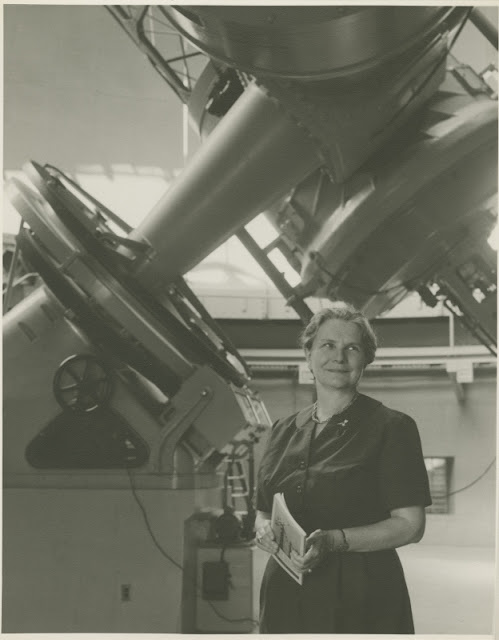Helen Sawyer Hogg
 |
| American Astronomer Helen Sawyer Hogg Credit: The Canadian Encyclopedia |
Helen Sawyer was born in Lowell, Massachusetts in August 1905. She enrolled at Mount Holyoke College in 1922, receiving her bachelor's degree four years later. Sawyer initially planned on studying chemistry but changed to astronomy after her astronomy professor at Mount Holyoke College took her class on a field trip to observe a total solar eclipse in 1925. She later recalled that the "glory of the spectacle seems to have tied me to astronomy for life." (I completely understand this after witnessing the August 2017 total solar eclipse in the United States)! After graduating with her bachelor's degree, she moved on to studying astronomy for her master's and doctoral degrees which she received from Radcliffe College (a sister college to Harvard University at the time). While at Radcliffe, Sawyer studied under renowned astronomer Harlow Shapley at the Harvard College Observatory. Her doctoral research focused on variable stars (stars whose brightness changes in either a regular or irregular way) and globular star clusters (spherical collections of old stars).
While pursuing her graduate studies, Sawyer met and married Frank Scott Hogg, a Canadian Harvard astronomy graduate student. The couple moved to Victoria, British Columbia in 1931, where Frank began work at the Dominion Astrophysical Observatory. At the time, public institutions weren't allowed to hire both husband and wife, so Sawyer Hogg wasn't able to work for pay at the observatory. However, she received permission to use the facility's large telescope to carry out unpaid research on star clusters, so at least there's that.
 |
| Helen Sawyer Hogg beside the David Dunlap Observatory's optical telescope; 1960. Credit: The Canadian Encyclopedia |
In 1935, Frank was hired by the Department of Astronomy at the University of Toronto, and Sawyer Hogg was able to continue her research there on a volunteer basis. A year later, she officially became affiliated with the university as a research assistant. By 1941, with many men leaving to fight in World War II, additional opportunities for women became available; Sawyer Hogg became a lecturer at this time. She became a full professor in 1957 and was named professor emeritus upon her retirement in 1976.
During her time at the University of Toronto, Sawyer Hogg utilized the David Dunlap Observatory's immense telescope to take thousands of images of the Milky Way Galaxy (our own galaxy). She carefully analyzed this data which resulted in her authorship of over 200 scholarly reports and articles, including A Catalogue of 1116 Variable Stars in Globular Star Clusters in 1939. This was such an important contribution to the astronomical community that it was updated twice - in 1955 and 1973.
In addition to conducting research, Sawyer Hogg was an active public engagement enthusiast, giving astronomy lectures which were broadcast on the radio, hosting an eight-episode television show, and writing a weekly column called With the Stars for the Toronto Star (Canada's largest newspaper) from 1951 to 1981. Her most well-known book, The Stars Belong to Everyone: How to Enjoy Astronomy, was published in 1976.
Sawyer Hogg significantly advanced our understanding of globular clusters and contributed greatly to the public's knowledge of astronomy. Through both her research and public engagement activities, she undoubtedly inspired numerous women to enter scientific professions. To honor Sawyer Hogg, the University of Toronto's Southern Observatory, in Chile, named its telescope the Helen Sawyer Hogg Telescope in 1992.



Comments
Post a Comment